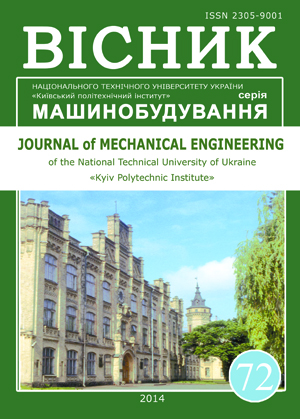STRAIN BEHAVIOUR AND FRACTURE RESISTANCE OF PIPELINE STEELS IN HYDROGEN-CONTAINED ENVIRONMENT
DOI:
https://doi.org/10.20535/2305-9001.2014.72.37017Keywords:
low-alloyed steels, hydrogen-contained environments, static and cyclic loading, hydrogenation of metal and hydrogen concentration, hydrogen embrittlement.Abstract
The work is dedicated to the evaluation of strength and risk of fracture of low-alloyed pipeline steels under presence of the hydrogen-contained environments.
Purpose. The assessment of hydrogen concentration effect in metal on strength and serviceability of pipeline steels under static and cyclic loading was the aim of presented study.
Design/methodology/approach. The study was realised with using of the methods of physical chemistry, mechanics of materials and materials science.
Findings. The relationship between hydrogen concentration in metal and work for initiation of the local fracture emanating from the notches has been derived. The evaluation of fatigue crack growth rate in pipeline steel with taking into account of local hydrogen concentration near the crack tip was made and it has been found that fatigue crack growth rate is the function of some critical combination of following parameters: local hydrogen concentration at the crack tip, hydrogen concentration in bulk of metal and range of stress intensity factor.
Originality/value. The existence of some critical hydrogen concentration, which causes the significant loss of local fracture resistance of given steels, was shown. This critical value can be considered as an important engineering parameter for strength and fracture assessment of materials and structural components in hydrogenous environments.
References
Hanneken J.W., Hydrogen in metals and other materials: a comprehensive reference to books, bibliographies, workshops and conferences, International Journal of Hydrogen Energy, 1999, V. 24, Is. 10, pp. 1005–1026.
Effects of Hydrogen on Materials: Proceedings of the 2008 International Hydrogen Conference, Ed. by Brian Somerday, Petros Sofronis, Russell Jones, Ohio (USA): ASM International, Materials Park, 2009, 766 p.
Capelle J. Comparative assessment of electrochemical hydrogen absorption by pipeline steels with different strength. J. Capelle, I. Dmytrakh, G. Pluvinage. Corrosion Science. 2010. V. 52, Is. 5. P. 1554–1559.
Capelle J., Gilgert J, Dmytrakh I., and all. The effect of hydrogen concentration on fracture of pipeline steels in presence of a notch, Engineering Fracture Mechanics, 2011, V. 78, Is. 2, pp. 364–373.
Capelle J., Gilgert J, Dmytrakh I., and all, Sensitivity of pipelines with steel API X52 to hydrogen embrittlement, International Journal of Hydrogen Energy, 2008, V. 33, Is. 24, pp. 7630–7641.
Dmytrakh I.M., Smiyan O.D., Syrotyuk A.M., and all, Relationship between fatigue crack growth behaviour and local hydrogen concentration near crack tip in pipeline steel, International Journal of Fatigue, 2013, V. 50, pp. 26–32.
Dey S., Mandhyan A.K., Sondhi S.K., and all, Hydrogen entry into pipeline steel under freely corroding conditions in two corroding media, Corrosion Science, 2006, V. 48, Is. 9, pp. 2676–2688.
Cheng Y.F., Niu L. Mechanism for hydrogen evolution reaction on pipeline steel in near-neutral pH solution, Electrochemistry Communications, 2007, V. 9, Is. 4, pp. 558–562.
Yan M., Weng Y. Study on hydrogen absorption of pipeline steel under cathodic charging, Corrosion Science, 2006, V. 48, Is. 2, P. 432–444.
VoltaLab 40 (PGZ301 & VoltaMaster 4). Dynamic Electrochemical Laboratory. Instruction. Radiometer Analytical, 2009. 126 р.
Grodoi W., Kuromoto N.K., Guimaraes A.S., and all, Effect of the hydrogen outgassing time on the hardness of austenitic stainless steels welds, Materials Science and Engineering: A, 2003, V. 354, Is. 1–2, pp. 251–256.
Gavriljuk V.G., Shivanjuk V.N., Foct J. Diagnostic experimental results on the hydrogen embrittlement of austenitic steels, Acta Materialia, 2003, V. 51, Is. 5, pp. 1293–1305.
Dmytrakh І.М., Leschak R.L., Syrotyuk A.M., and all, The influence of bulk hydrogen concentration in metal on peculiarities of low-alloyed pipeline steel deformation, Physicochemical mechanics of materials, 2014, V. 50, No 2, pp. 16–23.

